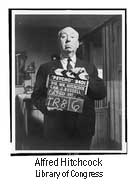When a film is working, none of the individual elements stand out; that is, we are so caught by the complete work that we aren’t conscious of where the camera is positioned or what filters cover the lens or whether an actor is reciting a script or improvising. Such matters are for subsequent viewings; in fact, one of the singular pleasures of watching a really great film, say a Citizen Kane, is in knowing we can go back later to pick it apart.
And so with film music. You may go later to buy a film’s soundtrack, but you shouldn’t be thinking about that journey while watching the film. When the background music becomes obvious, when it pulls us from the narrative, something has gone terrible wrong. For better or for worse, the tradition of narrative filmmaking has conditioned us to expect a seamless integration of all the filmic parts.

Examples abound where the soundtrack of a film has ravaged an otherwise good story, especially from the sixties and seventies, the freewheeling decades following the collapse of the studio era. Recently I saw the cult horror film The Wicker Man (1973) with my wife and had to practically hold her to the chair through some of the musical interludes, which smacked of the quirkiness and false ebullience of the seventies. I’ve had similar moments myself revisiting films from Dirty Harry (1971) to American Graffiti (1973), and, I am somewhat hesitant to say, Easy Rider (1969). The music inordinately draws attention to the unfortunate era that produced it.
This is the problem for many films with pop music tracks from the past few decades–pop music has a short shelf life. (Someone should tell this to the many critics falling over one another in praise of the quirky Moulin Rouge! (2001)).
Film music most often is used to set a mood. Viewers care first about story. Add an appropriate mood to a good story and you have the beginning of something. Think of those great Bernard Herrmann scores to Hitchcock films like North by Northwest, or Psycho. Hermann wasn’t trying to be hip or trendy. His was a humbler labor. A more recent example might be the fine John Williams tracks for Star Wars, Indiana Jones, and Minority Report. Or the great soundtracks for Chariots of Fire (1981), The Mission (1986), and The Last of the Mohicans (1992).
Sometimes a soundtrack can be extremely large and still work, as in David Lean’s 1945 classic Brief Encounter with its masterful integration of Rachmaninof’s Piano Concerto in C Minor, or in the recent O Brother, Where Art Thou? with its great folk soundtrack? However, these are exceptions to the general rule that with film music, discretion and humility is best.
A word about the musical. Even musicals draw criticism when the music overwhelms the story. Most connoisseurs of the form prefer the sophisticated stories of An American in Paris (1951) and Chicago to the more primitive Busby Berkeley “putting on the show” stories which make you extremely aware of the coming on of song and dance numbers. And as for the pop music musicals like Saturday Night Fever (1977), Grease (1978), Tommy (1975) or Moulin Rouge!, well… Judy Garland took us somewhere over the rainbow; I don’t think the Bee-Gees ever accomplished quite that.
